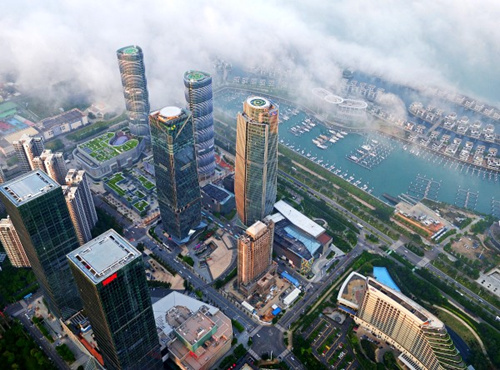Marine ecological protection in Xiamen
Author : SHEN RUFA Source : Chinese Social Sciences Today 2017-09-07

As a beautiful coastal city, Xiamen is where the sea meets with the land.
Xiamen, in Fujian Province, has many titles, including the UN Habitat Scroll of Honor Award, International Garden City, National City of Excellence in Civil Ethics, National Model City for Environmental Protection and more. All of these titles, in some way or another, are associated with the ocean. Locals, too, have many reasons to love the sea.
Residents on the Gulangyu Island, a pedestrian-only island off the coast of Xiamen, can see Chinese white dolphins capering about in the sea; Huangcuo beach, a newly-developed tourist spot in Xiamen, has the country’s only national reserve for lancelets; and Xiamen is also a habitat of egrets, and was hence nicknamed “Island of Egrets.”
According to statistics from the local government in Xiamen, Xiamen Bay is habited by nearly 2,000 species of marine creatures, quite a few of which are valuable or rare. In 2012, the city was included in the first batch of state-level marine ecological civilization demonstration zones.
The destiny of Xiamen is closely related to that of the sea, because it is supported by the marine economic system, incorporating the shipping industry, seashore tourism, coastal industries, and marine high-tech industries. In 2016, the added value of marine industries in Xiamen reached 54.33 billion, accounting for 14.4 percent of the city’s GDP.
The good ecological conditions not only ensure a favorable habitat for marine species, but also attract visitors. Many people come to Xiamen just for the beautiful, clean sea and beaches.
Xiamen covers a land area of about 1,600 square kilometers and a sea area of 390 square kilometers. Its shoreline extends for 226 kilometers, including 31.7 kilometers of deep-water shoreline.
The sea area in Xiamen was once densely covered with marine litter. Great changes took place from 1998 to 2008 when authorities invested billions of RMB to regulate the environment. Due to measures like sea reclamation, the capacity of water exchange at the area was improved and marine litter produced by cultivation was cleared away.
Floating garbage has become the main source of pollution in recent years. More than 7 percent of Xiamen’s floating garbage flowed in from the Jiulong River. In order to deal with this problem from its source, Xiamen worked with Zhangzhou and Longyan, both in Fujian Province along the Jiulong River, to improve the environment around the sea area.
According to an official from the bureau of ocean and fishery in Xiamen, there are now more than 20 salvage ships around the sea area clearing up about 1,600 tons of sea garbage every year. According to recent figures, a total of 170 million cubic meters of marine mud has been dredged, thus increasing the tidal influx by more than 50 million cubic meters.
Another project is the removal of the dike at the Dadeng sea area to build a bridge, improve hydrodynamic condition and water quality, and reduce marine litter.
Xiamen’s beach restoration practices are also well-known around the country. The 60 hectares of mangrove forest constructed for marine ecological restoration at the Xiatanwei sea area in Xiang’an District are now pleasant scenery. Altogether, 30 kilometers of coastland have been restored and more than 1 million square meters of artificial beaches have been built.
To provide institutional guarantees, the authorities in Xiamen have issued more than 30 laws and regulations pertaining to sea protection. Environmental protection volunteers and non-governmental organizations are also taking part in the protection work. Wang Zhongwu, the leader of a non-governmental organization in Siming District, said “The sea in Xiamen is our home. Everyone has the responsibility to protect it.”
Ye Shengtao made Chinese fairy tales from a wilderness
Ye Shengtao (1894–1988) created the first collection of fairy tales in the history of Chinese children’s literature...
-
How northern ethnicities integrated into Chinese nation
2023-09-18
-
Mogao caves
2023-09-12
-
Mogao Grottoes as ‘a place of pilgrimage’
2023-09-12
-
Time-honored architectural traditions in China
2023-08-29
-
Disentangling the civilizational evolution of China
2023-08-28
-
AI ethics in science fiction
2023-08-23














 2011-2013 by www.cssn.cn. All Rights Reserved
2011-2013 by www.cssn.cn. All Rights Reserved